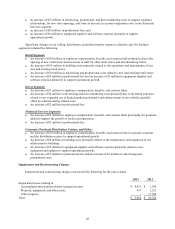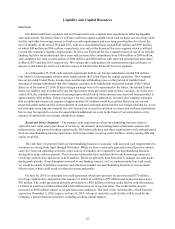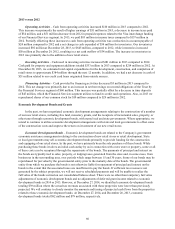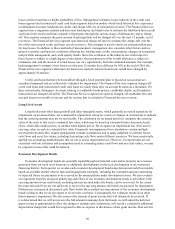Cabela's 2014 Annual Report Download - page 67
Download and view the complete annual report
Please find page 67 of the 2014 Cabela's annual report below. You can navigate through the pages in the report by either clicking on the pages listed below, or by using the keyword search tool below to find specific information within the annual report.57
the joint final rules revise the agencies’ prompt corrective action framework by introducing a common equity
tier 1 capital requirement and a higher minimum tier 1 capital requirement. In addition, the interim final rules
and the joint final rules include a supplementary leverage ratio for depository institutions subject to the advanced
approaches capital rules. The phase-in period for the interim final rules began in January 2015 for WFB. WFB has
assessed how the interim final rules and the joint final rules will impact it and its ability to comply with the new
common equity tier 1 capital requirement and higher minimum tier 1 capital requirement and has concluded that
the impact will be minimal.
Also, in response to certain liquidity requirements under Basel III, the noteholders under one of the variable
funding facilities issued under WFB’s securitization program have requested and obtained amendments to their
respective transaction documents permitting them to delay funding an advance requested under that facility for up
to 35 days. It is not currently known what, if any, changes to their respective transaction documents the noteholders
under the other variable funding facilities issued under WFB’s securitization program will request in response to
the Basel III liquidity requirements. These changes could delay or disrupt access to funding under the variable
funding facilities. Moreover, the liquidity requirements under Basel III could result in an increase in the borrowing
costs under the variable funding facilities.
The ability of the Financial Services segment to engage in securitization transactions on favorable terms or at
all could be adversely affected by disruptions in the capital markets or other events, which could materially affect
our business and cause the Financial Services segment to lose an important source of capital. The Reform Act,
which was signed into law in July 2010, will also affect a number of significant changes relating to asset-backed
securities, including additional oversight and regulation of credit rating agencies and additional reporting and
disclosure requirements.
In addition, several rules and regulations have recently been proposed or adopted that may substantially affect
issuers of asset-backed securities. On September 19, 2011, the SEC proposed a new rule under the Securities Act
of 1933, as amended, to implement certain provisions of the Reform Act. Under the proposed rule, an underwriter,
placement agent, initial purchaser, or sponsor of an asset-backed security, or any affiliate of any such person,
shall not at any time within one year after the first closing of the sale of the asset-backed security, engage in
any transaction that would involve or result in any material conflict of interest with respect to any investor in a
transaction arising out of such activity. The proposed rule would exempt certain risk-mitigating hedging activities,
liquidity commitments, and bona fide market-making activity. It is not clear how the final rule will differ from the
proposed rule, if at all. The final rule’s impact on the securitization market and the Financial Services segment is
also unclear at this time.
The Trust is structured to qualify for the exemption from the Investment Company Act provided by
Investment Company Act Rule 3a-7. On August 31, 2011, the SEC issued an advance notice of proposed rulemaking
regarding possible amendments to Investment Company Act Rule 3a-7. At this time, it is uncertain what form the
related proposed and final rules will take, whether the Trust would continue to be eligible to rely on the exemption
provided by Investment Company Act Rule 3a-7, and whether the Trust would qualify for any other Investment
Company Act exemption.
On August 27, 2014, the SEC adopted certain rules (“SEC Regulation AB II”) that will change the disclosure,
reporting, and offering process for public offerings of asset-backed securities, including those issued under WFB’s
securitization program. SEC Regulation AB II had been originally proposed by the SEC on April 7, 2010, and was
reproposed by the SEC on July 26, 2011. As originally proposed and re-proposed, SEC Regulation AB II would
have required the disclosure of group-level data regarding the receivables in a credit card securitization, but this
requirement was not included in the final rule as adopted. There can be no assurances that the SEC will not require
disclosure of group-level data in credit card securitizations in the future. We are continuing to assess the impact of
SEC Regulation AB II on WFB’s securitization program.
On October 22, 2014, pursuant to the provisions of the Reform Act, the FDIC, the SEC, the Federal Reserve
and certain other federal agencies adopted regulations that impose a five percent risk retention requirement for
credit card securitizations that are issued after December 2016. We have not determined whether WFB’s existing
























